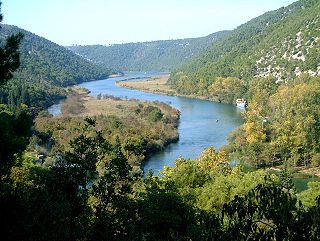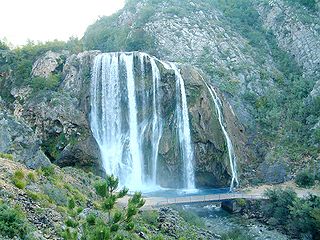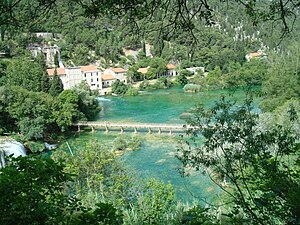
Krka National Park is one of the Croatian national parks, named after the river Krka that it encloses. It is located along the middle-lower course of the Krka River in central Dalmatia, in Šibenik-Knin county, downstream Miljevci area, and just a few kilometers northeast of the city of Šibenik. It was formed to protect the Krka River and is intended primarily for scientific, cultural, educational, recreational, and tourism activities. It is the seventh national park in Croatia and was proclaimed a national park in 1985.

The Una is a border river between Bosnia and Herzegovina and Croatia and a right tributary of the Sava river. It is part of the Black Sea drainage basin, and its watershed has a size of 10,200 km2 (3,900 sq mi), of which 8,080 km2 (3,120 sq mi) belongs to Bosnia and Herzegovina, and 2,120 km2 (820 sq mi) to Croatia. The total length of the river is 212 km (132 mi). The source of the river is located near the village of Donja Suvaja in Croatia, and its mouth is located near the village of Jasenovac, on the border with Bosnia. The largest right tributaries are the Krka, Unac, Krušnica and Sana rivers, and the largest left tributary is the Klokot river. Its longest headwater is the Unac river. The largest and most important city located on the river is Bihać. Other, important cities and towns are Bosanska Krupa, Bosanski Novi and Bosanska Kostajnica. The river is characterized by a multitude of waterfalls, rapids, karst springs and relatively untouched nature. A large part of the upper river is part of the Una National Park.

The Krka is a river in Croatia's Dalmatia region, known for its numerous waterfalls. It is 73 km (45 mi) long and its basin covers an area of 2,088 km2 (806 sq mi). It was known in ancient Greek as Kyrikos, or maybe also as Catarbates by the ancient Greeks, it was known to the ancient Romans as Titius, Corcoras, or Korkoras.

Ante Šupuk was a Croatian politician and entrepreneur who served as a mayor of Šibenik. In 1895 he built the Jaruga Hydroelectric Power Plant as one of the world's first hydroelectric power plants, and connected it to a lighting system using alternating current. It was the first of its kind in Dalmatia and Croatia.

Hrvatska elektroprivreda is a national power company in Croatia which has been engaged in electricity production, transmission and distribution for more than one century, and with heat supply and gas distribution for the past few decades. HEP Group is organized in the form of a holding company with a number of daughter companies.
Senj Hydroelectric Power Plant is a large high-pressure diversion power plant harnessing the Lika and Gacka Rivers water in Croatia. Senj HPP has four turbines with a nominal capacity of 72 MW each having a total capacity of 220 MW.
Vinodol Hydro Power Plant is a large power plant in Croatia that has three turbines with a nominal capacity of 30 MW each having a total capacity of 90 MW.
Zakučac Hydroelectric Power Plant is a large power plant in Croatia that has four turbines with a nominal capacity of 122 megawatts (164,000 hp) each having a total capacity of 488 megawatts (654,000 hp).

Čakovec Hydroelectric Power Plant is a large hydroelectric power plant in Croatia that has four turbines with a total nominal capacity of 78 MW. According to the type of power plant, it is a flow, low-pressure, derivation hydroelectric power plant with an accumulation (area of 10.5 km2 and volume of 51.6 [hm^3] for daily and partial weekly flow regulation. Units A and B of the power plant have horizontal pipe turbines and the generators are "in the bulb".
Dubrovnik Hydro Power Plant is a large power plant in Croatia that has two turbines with a nominal capacity of 125 MW each having a total capacity of 250 MW.

Miljacka Hydroelectric Power Plant is a hydroelectric power plant on the river Krka, located in Šibenik-Knin County, in central Dalmatia, Croatia.
Golubić Hydroelectric Power Plant is a hydroelectric power plant on river Butišnica located in Šibenik-Knin County, in central Dalmatia, Croatia.

Krčić Hydroelectric Power Plant is a hydroelectric power plant on river Krka, located in Šibenik-Knin County, in central Dalmatia, Croatia.

Roški Slap Hydroelectric Power Plant is a hydroelectric power plant on river Krka, located in Šibenik-Knin County, in central Dalmatia, Croatia.
Varaždin Hydroelectric Power Plant is a hydroelectric power plant on the river Drava, near the city of Varaždin located in Varaždin County, in northwest Croatia.

Ozalj Hydroelectric Power Plant is a hydroelectric power plant on river Kupa, in its central stretch, in town of Ozalj, Karlovac County, Croatia.

Energy in Croatia describes energy and electricity production, consumption and import in Croatia.

The Ombla is a short river in Croatia, northeast of Dubrovnik. Its course is approximately 30 metres long, and it empties into the Rijeka Dubrovačka, ria formed by the Adriatic Sea near Komolac in Dubrovnik-Neretva County. Rijeka Dubrovačka is actually a ria, a flooded river valley formed through changes in sea surface elevation on a geologic time scale. The river rises as a karst spring fed by groundwater replenished by Trebišnjica, which is an influent stream flowing in Popovo Polje, in the immediate hinterland of the Ombla. The elevation difference between the river's source and its mouth is just over 2 metres. The average discharge of the river is 24.1 cubic metres per second. The drainage basin of the Ombla encompasses 600 square kilometres and, besides the short surface course, includes only groundwater flow.

Trebinje I Hydroelectric Power Station or Trebinje-1 Hydroelectric Power Station is hydroelectric power plant (HPP) on the Trebišnjica River near Gornje Grančarevo in the municipality of Trebinje in Bosnia and Herzegovina. Trebinje-1 HPP is accumulation with dam toe powerhouse type of facility with a large Grančarevo arch dam. At the height of 123 m (404 ft), Grančarevo dam is the tallest dam in the country. Its reservoir, Bileća Lake, is the largest by volume in Bosnia and Herzegovina as well. The dam provides for flood control and hydroelectric power generation at Trebinje-1 HPP. The dam was completed in 1967 and its 180 MW power station, A smaller 8 MW power station, Treblinje-2, was completed downstream in 1979.























